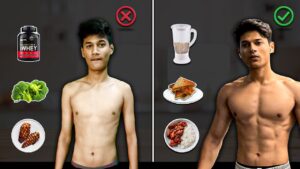Weight loss vs Fat loss
In the world of health and fitness, weight loss vs fat loss are often used interchangeably, but they represent two distinct concepts with different implications for your health and fitness goals. Understanding the difference between fat loss vs weight loss is crucial for making informed decisions about your fitness journey and achieving long-term success. Let’s explore the key differences, the factors involved, and why focusing on fat loss is often the better approach for sustainable health improvement.
Table of Contents

What is Weight Loss?
Weight loss refers to a decrease in body weight. This can be achieved through a combination of factors, such as a reduction in body fat, muscle mass, water weight, or even organ size. When people talk about “losing weight” they often refer to seeing a smaller number on the scale, but this doesn’t necessarily mean that the weight lost is from fat.
There are various ways in which you can lose weight, such as:
- Caloric Deficit: Consuming fewer calories than your body burns, which forces it to use stored energy (fat or muscle) to make up for the deficit.
- Exercise: Physical activity can help burn calories and contribute to weight loss.
- Dehydration: Excessive sweating, low fluid intake, or even diuretics can temporarily reduce water weight.
While weight loss can be a sign of progress, especially when it’s part of a targeted plan, it’s important to note that losing weight quickly or drastically can lead to the loss of lean muscle mass or dehydration, both of which are not ideal outcomes.
What is Fat Loss?
Fat loss refers specifically to the reduction of stored fat in the body, particularly subcutaneous fat (the fat under the skin) and visceral fat (the fat around organs). Unlike weight loss, which is a measure of total body weight, fat loss is a targeted process of losing body fat without compromising lean muscle mass or other vital components of health.
Fat loss occurs when the body is in a caloric deficit, meaning you burn more calories than you consume. However, the goal is to ensure that the body uses fat as the primary energy source, not muscle. This is achieved by creating a sustainable deficit, combining proper nutrition, strength training, and cardiovascular exercise.
Key components of fat loss include:
- Dietary Adjustments: Reducing calorie intake while ensuring sufficient protein and nutrient intake to preserve lean muscle.
- Exercise: A combination of strength training (to build or preserve muscle) and cardiovascular exercise (to burn calories and increase fat oxidation).
- Rest and Recovery: Sleep and recovery are critical for fat loss, as muscle repair and fat-burning processes occur during rest.
Weight Loss vs Fat Loss key points
| Factor | Weight Loss | Fat Loss |
|---|---|---|
| Focus | General reduction in body weight | Reduction of body fat while preserving muscle |
| Measurement | Can involve loss of water, muscle, or fat | Focuses on losing fat, not muscle or water |
| Speed | Can occur rapidly, especially with extreme diets | Generally slower and more gradual |
| Health Impact | Rapid weight loss can lead to muscle loss, dehydration, or nutrient deficiencies | Focuses on preserving muscle mass and overall health |
| Approach | Often short-term, drastic methods (e.g., crash diets) | Long-term, sustainable methods (e.g., balanced diet and exercise) |

Why Fat Loss is More Important than Weight Loss
While the number on the scale might be tempting to focus on, fat loss should be the ultimate goal for improving body composition and overall health. Here are a few reasons why:
- Preserving Muscle Mass: When you focus on fat loss, you’re more likely to retain lean muscle mass, which is essential for metabolism, strength, and overall function. Muscle burns more calories at rest than fat, so preserving muscle helps to maintain a higher metabolic rate, making it easier to sustain a healthy weight in the long term.
- Improved Health Metrics: Fat loss—especially the reduction of visceral fat (fat around the organs)—can have profound effects on your health. Visceral fat is associated with numerous chronic diseases such as heart disease, type 2 diabetes, and high blood pressure. Losing fat can improve these health markers significantly, even if the total weight lost is modest.
- Better Physical Appearance: Reducing body fat helps to improve muscle definition and overall body composition, giving a leaner and more toned appearance. While weight loss might cause a decrease in size, it can sometimes result in a flabby or saggy look, especially if muscle mass is lost in the process.
- Sustainability: Fat loss is a sustainable goal that can be maintained over time, whereas drastic weight loss can often lead to rebound weight gain. Extreme weight loss methods, such as fad diets or excessive calorie restriction, may lead to short-term results but are difficult to maintain and can be harmful to your health.
- Improved Energy and Performance: When you focus on fat loss while preserving muscle, you’ll likely experience better energy levels, improved athletic performance, and enhanced overall strength.
How to Focus on Fat Loss
- Create a Caloric Deficit: To lose fat, you need to burn more calories than you consume. However, the key is to do this in a gradual and sustainable way, rather than drastically cutting calories, which could result in muscle loss or other health issues.
- Prioritize Protein: A higher protein intake helps preserve muscle mass while in a caloric deficit. It also promotes satiety, helping to control hunger and reduce overall calorie intake.
- Strength Training: Incorporating resistance exercises (weight lifting, bodyweight exercises, etc.) helps to build and maintain lean muscle, which supports fat loss and improves body composition.
- Cardiovascular Exercise: Activities like walking, running, cycling, or swimming can help burn additional calories and improve heart health. However, excessive cardio without strength training may lead to muscle loss.
- Get Adequate Rest and Recovery: Sleep plays a critical role in fat loss. Inadequate sleep can disrupt hormones like cortisol (a stress hormone), which can negatively impact fat storage and muscle recovery.
- Be Patient and Consistent: Fat loss takes time and consistency. Aim for slow, steady progress rather than quick fixes. Sustainable fat loss is a gradual process that requires discipline and a balanced approach to diet and exercise.
Conclusion
While weight loss and fat loss are often used interchangeably, focusing on fat loss is the smarter and healthier choice for long-term health and fitness. Fat loss allows for the preservation of lean muscle mass, a reduction in harmful fat stores (such as visceral fat), and an overall improvement in body composition and health markers. By adopting a balanced approach of proper nutrition, strength training, and consistent exercise, you can achieve a healthier body and more sustainable results.
Remember, the number on the scale is just one piece of the puzzle. Focus on how you feel, how your body moves, and the positive changes in your health as you work toward your fat loss goals.
Can I lose fat without losing weight?
Yes, it’s possible to lose fat without seeing significant changes in weight. This often happens when you lose fat while simultaneously gaining or preserving muscle. Here’s how:
Muscle Gain: Muscle tissue is denser than fat, meaning it takes up less space but weighs more. If you’re engaging in strength training (like weight lifting), you may build muscle while shedding fat, which might not show as a drastic change on the scale but will lead to visible improvements in body composition.
Body Recomposition: When you focus on fat loss (through a caloric deficit) and muscle preservation (through resistance training and adequate protein intake), you can reduce fat while gaining muscle. This can result in a leaner appearance without major fluctuations in weight.
Tracking other metrics, such as body measurements, body fat percentage, or how your clothes fit, can give you a better understanding of fat loss progress than relying solely on the scale.
Are fat loss and weight loss different?
Yes, fat loss and weight loss are different:
Weight Loss: Refers to a decrease in total body weight. This can include a loss of fat, muscle, water, and even bone mass. Weight loss can occur through extreme caloric restriction, dehydration, or rapid dieting, and it doesn’t necessarily lead to healthier body composition or improved health.
Fat Loss: Specifically refers to the reduction of stored body fat, particularly the harmful visceral fat that surrounds organs. Fat loss focuses on preserving or building lean muscle mass while burning excess fat, typically through a combination of a controlled calorie deficit, proper nutrition, and exercise.
In short, fat loss is a more specific, health-focused goal that leads to better body composition and long-term health benefits compared to general weight loss.
How do you know if you are losing weight or fat?
The most reliable way to determine whether you’re losing fat or just weight is to track multiple metrics rather than focusing solely on the number on the scale. Here are a few ways to differentiate between fat loss and weight loss:
Body Composition Measurement:
Body Fat Percentage: The most direct way to know if you’re losing fat is to track your body fat percentage. If this number is decreasing, you’re losing fat. Methods include calipers, bioelectrical impedance scales, or more advanced options like DEXA scans or hydrostatic weighing.
Progress Photos and Measurements: Taking progress photos and measuring body parts (waist, hips, thighs, arms) can show visible changes in fat loss even when the scale stays the same.
Scale Weight: If you’re losing weight without seeing any changes in body composition, it may be due to water loss or muscle loss. If you are losing fat, you’ll typically see changes in how your clothes fit and the shape of your body, even if the scale doesn’t change drastically.
Strength and Performance: If you’re able to maintain or improve your strength, endurance, and physical performance during exercise, it’s a good sign you’re preserving muscle mass. Muscle loss, on the other hand, may lead to reduced strength or fatigue.
Clothing Fit: If your clothes start to feel looser, especially around the waist, hips, or thighs, it’s a strong indicator of fat loss, even if the scale shows minimal change. Fat loss usually leads to a more toned and defined appearance, particularly in areas where body fat is more pronounced.
Is it better to lose weight or lose fat?
While both weight loss and fat loss can improve your appearance and health, losing fat is generally the better option for long-term health, fitness, and body composition. Here’s why:
Fat loss specifically targets the reduction of body fat while preserving muscle mass, which is essential for a higher metabolic rate, better strength, and improved physical appearance.
Weight loss, on the other hand, can involve losing muscle, water, or even bone mass, which can slow down your metabolism, reduce energy, and negatively affect overall health.
In short, focusing on fat loss is more beneficial because it promotes a leaner, healthier body with lasting results. Plus, muscle mass is key for long-term fat burning.










